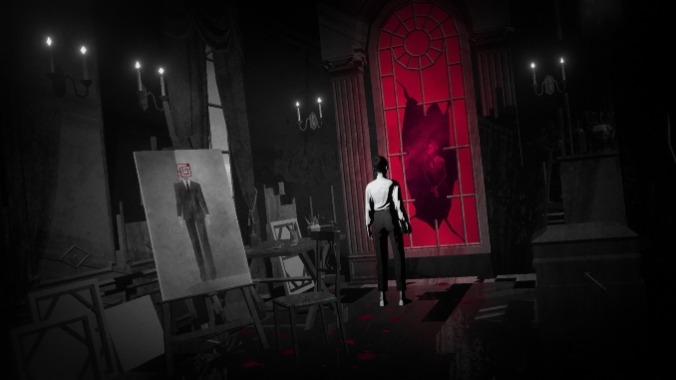Lorelei and the Laser Eyes Is a Postmodern Maze Worth Getting Lost In

During my undergrad, I took an introductory game design course that ended with me and two other starry-eyed freshmen making a game together. In theory, it wasn’t supposed to be anything too elaborate, an hour-ish-long experience that we’d make using the relatively straightforward visual novel engine Ren’Py. But of course, even the smallest videogame is often a nightmare to put together, and I vividly remember how much I struggled with what was initially envisioned as the climax, a maze.
Try as we might, we couldn’t figure out how to make this sequence anything besides a tedious slog that made the player feel more like the Minotaur than Theseus with his string. In the end, we scrapped most of it. It’s a problem that I imagine many designers face when trying to create something similar because the theoretical wonder and mystery of exploring a labyrinth often come up short next to the frustrating reality of bumping into identical walls as you fumble toward an exit.
I bring all this up because unlike us struggling college students, Lorelei and the Laser Eyes, the latest from Simogo (Sayonara Wild Hearts, Year Walk, Device 6), fundamentally understands how to present enrapturing mazes, whether they be literal or metaphorical. Its uncompromisingly Byzantine gameplay is structured like one, creating a twisting path of tough but fair puzzles that almost always offer just enough guidance to create enticing challenges. Meanwhile, its storytelling dovetails with this approach and delivers mystifying narrative threads that only become tangible as you journey further into these depths. Using both these avenues, it eventually digs into why those like King Minos created a labyrinth in the first place: to hide truths they’d rather forget.
But before going deeper, I’ll explain the basics. Things pick up as an unnamed, chicly dressed woman arrives for a business trip at a Central European estate, the Hotel Letztes Jahr. She’s supposed to meet with a famous Italian filmmaker (think Fellini but with trashier films) to collaborate on an unspecified art project. Unfortunately for her, things quickly go off the rails. To fully understand what’s going on and why she came to this place, she must explore this elaborate locale that would fit in nicely alongside the convoluted architecture of a Resident Evil game (and if this building didn’t remind you of Spencer Mansion, the fixed camera angles certainly will).

As for what you do as the player, there are three main actions. You move around, interact with what’s in front of you, or open the document menu. Using these tools, you solve puzzles. Lots and lots and lots of puzzles. Puzzles that almost always lead to, you guessed it, more puzzles.
While I went into Lorelei and the Laser Eyes expecting a shortish tone piece with some light puzzles, such as some of Simogo’s previous titles like Year Walk or Device 6, their latest is a twenty-to-thirty-hour long beast full of brain-twisting challenges that require keeping a pencil and notebook on hand. This hotel is littered with riddles and enigmas, and especially early on, the experience is more defined by staring in confusion at mysterious clocks, shut doors, and combination locks rather than solving much of anything. While some of these can be figured out with information found on-site, many require hints that can only be found in far-flung corners of the hotel.
This large-scale, interconnected string of challenges is undeniably daunting up front, but this approach has quite a few strengths. The first is that it’s simply engaging to explore this space and poke at its many funky doohickies as you try to make heads or tails of what’s going on. Much of this is part and parcel with Metroid-styled games, and it works just as well in this house-shaped presentation. Another boon that extends from this non-linear design is that you almost always have plenty of different puzzles to poke at, and when you hit a dead-end somewhere, there are usually other avenues to explore until you find an essential piece of intel or things click into place upstairs. And when you finally wrap back around and figure out some odd clue you first saw hours ago, the complexity of this sprawling setting only adds to the self-satisfaction and sense of accomplishment.
-

-

-

-

-

-

-

-

-

-

-

-

-

-

-

-

-

-

-

-

-

-

-

-

-

-

-

-

-

-

-

-

-

-

-

-

-

-

-

-









































